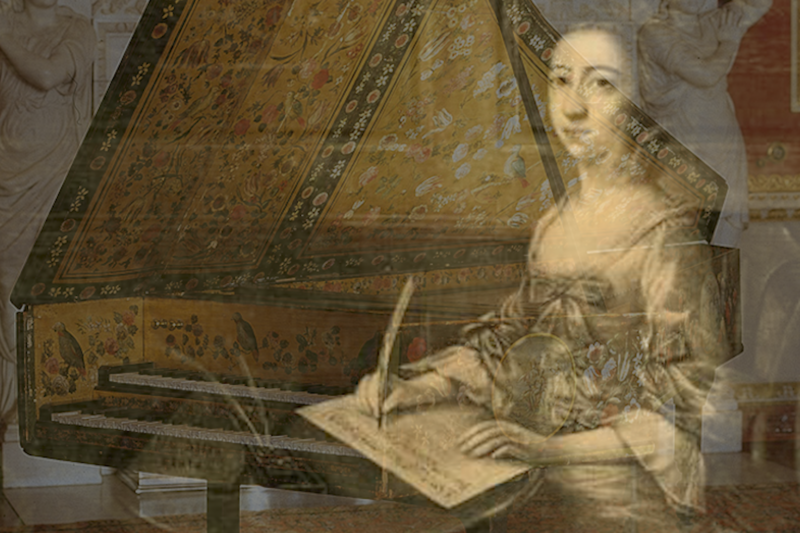Easier
A list

Elisabetta de Gambarini ~ Giga in D (A2) is an easy two-part piece. The choice of articulation is up to you. A simple and effective way to encourage the phrasing to dance along is to slur the first pair of the three-note quaver patterns, and to separate the crotchet - quaver momentum.
Apart from the appoggiaturas in bars 6 and 33 (which are best omitted on account of the harmonic clash), the ornamentation according to the suggestions in print should work well. If your pupil is struggling to fit sufficient notes in, then change the number of notes or omit it. Marks are not lost in the exam for changes to ornamentation but will be if the playing suddenly becomes uneasy or slower as a consequence of including it. For example, on page 7 an acciaccatura could work just as well on all the right hand indicated trills instead of a four-note trill. That would give the player just as much opportunity (if perhaps not more) to phrase the line in a poised way. Embellishment is the decoration, not the substance.
J.S.Bach ~ Invention No. 6 in E is an engaging piece of musical symmetry. In places, the hands move in parallel motion but are more often moving in contrary motion. Offset by a semiquaver syncopation, the piece has a certain inevitable momentum to it. It's as much a piece from which to learn about composition and counterpoint as it is to play.
Handel ~ Fantasia in A (A8) is very much a two-part piece that lies readily under the fingers. Detaching the quaver bass lines works well, musically. The semiquaver passages should flow nicely with a light legato and appropriately shaped touch. It's not so much the articulation that is responsible for the musical success of a particular performance, but the way in which the harmonic flow of the music is brought out through the shaping and phrase structure.
There are pieces that are technical fairly easy, but where the challenges are more of a musical nature. Scarlatti ~ Sonata in A (A10) is such a piece. Notice in the harpsichord version, played by Jean Rondeau, (where of course there is no sustaining pedal) the left hand crotchets are beautifully sustained with the fingers alone. In the piano version, played here by Maria Joao Pires, the right hand lines are treated as a single seamless line of embellishment.
Achieving a suitably appropriate degree of expressivity is key to making this piece as poetic as possible.
Hummel ~ Rondo in C (A11) is a very accessible piece for pianists at this grade level. There are no really challenging aspects of coordination. There are a few moments of right hand staccato thirds, but the phrasing should be fairly intuitive.
Telemann ~ Allegro (A13) is a fairly easy two-part piece with opportunities to vary the dynamics and shape the lines in suitably expressive ways. The quicker triplet figures are not difficult as long as good fingering is chosen.
_____________________________
B list

Granados ~ Vals poético (B2) is a sentimental piece, which goes to the heart of the Catalan soul. 'Con passione'...'con molto espressione'...'rall molto'...'ad libitum'...all litter the score as a teacher's nightmare, following years of getting pupils to play in time. Now is their opportunity not to!
That said, it's not any old 'not playing in time'. Rubato has musically logical ways of working. Much relies on knowing which part of the musical sentence you are heading towards when you begin that particular phrase. It also depends, metaphorically speaking, on having sufficiently strong lungs to sustain the beautifully singing tone through its longer right hand notes, without losing the quality and impetus of the phrasing.
Alicia de Larrocha, from a 1961 recording, does it this way:
Mendelssohn ~ Venetianisches Gondellied (B3) is a straightforward piece, albeit one of great expressive potential. The regular, gentle pushing of the gondolier's oar through the canals of Venice should be a feature in the interpretation, since it is an Andante 6/8. The gently caressing right hand thirds help to paint a romantic picture as the lovers glide smoothly through the narrow waterways. The emotion is not superficial or sentimental. It has the dark colour of mahogany where the grain of life lies hidden just below the surface.
York Bowen ~ A Pastel (B4) is a pleasant, easy piece comprising a chromatically meandering right hand melody with arpeggiated left hand chords and some lovely harmonic changes.
Dello Joio ~ Prayer of the Matador (B5) The very real possibility of being gored to death lies behind this poignant outpouring of grief, ahead of the imminent fight.
There can, in our view, be no justification for any glorification of this barbaric 'sport'. Perhaps, instead, we need to think about the many wrongs and suffering we have needlessly caused to others, including animals, through a lack of sufficient respect for their rights and feelings.
The Spanish soul is nonetheless a deeply caring and passionate one, something which has given rise to much heartfelt music, just as it does in Piazolla's wonderful 'Oblivion'.
If you'd like to get close to the soul of this music, there's probably no better way to share the tears expressed in such an impassioned way as this:
_____________________________
C list

Elissa Milne ~ Indigo Moon (C2) is indeed the kind of haunting piece that hangs around in the mind long after the piece has finished. The laid-back jazz style craves for that underpinning beat, hidden subtly away in the background, which ceaselessly keeps the music flowing. Let this happen and the piece should play itself, allow it to become too nostalgic and dreamy and it could start to turn to blancmange - not, possibly, what the composer had in mind.
Indigo Moon ~ Peter Noke
Stephen Montague ~ Tsunami (C9) will make a mess of your nice tidy living room for sure! If you have complaining neighbours, then open the windows and practise this at full tilt. It might lead them to appreciate the finer points of the Bach and Mozart you have been playing of late.
It is not only a very effective piece but, once you have found the location of the various chord clusters and worked out the interplay of hands in the loud cascades, an easy one to bring off musically. It demands bravura and, with the pedal often held for long spells, who is going to notice if you catch the odd wrong note as you try to hang onto something solid before getting swept off your feet?!
_____________________________
Other content in “Grade 6”
-
Current: Easier
